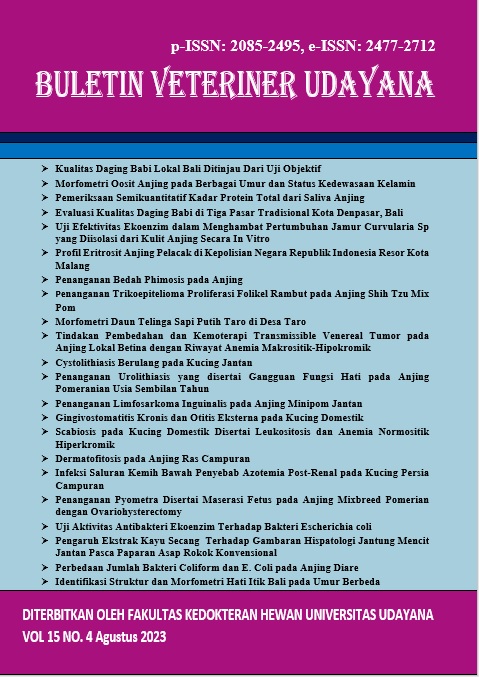SEMI-QUANTITATIVE EXAMINATION OF TOTAL PROTEIN LEVELS IN DOG SALIVA
Abstract
Dogs are quite popular animals in the pet category. Maintaining the dog's health as a pet is certainly one of the owner's priorities. On the other hand, the dog is also a major reservoir of various zoonotic disease infections. Early detection and effective, efficient treatment are needed to prevent the spread and increase in the severity of the disease. Saliva, which is one type of biological fluid, has begun to be widely used as a diagnostic sample. Its diverse components not only support each other in carrying out the function of saliva but can also be a biomarker of various infections or diseases in an individual. One of the components of saliva is protein. Protein has been shown to be the biomarker of various types of diseases in humans, such as gingivitis, periodontitis, cancer, and caries. This study examines the total protein level of dog saliva, which carried out on 15 healthy dogs. The saliva samples obtained were measured semi-quantitatively using the urine glucose-protein test kit. This study's data is presented in a frequency distribution of bar graphs and descriptive analyses. The results showed that the total protein levels of dog saliva varied, with the most dominant result being 0–10 mg/dL. Larger sample size and different measuring instruments can be applied in further research.
Downloads
References
Brunzel NA. 2018. Fundamentals of urine & body fluid analysis. 5th ed. Saunders Elsevier. St. Louis.
Contreras-Aguilar MD, Escribano D, Martínez-Subiela S, Martín-Cuervo M, Lamy E, Tecles F, Cerón JJ. 2019. Changes in saliva analytes in equine acute abdominal disease: a sialochemistry approach. BMC Vet. Res. 15(187): 4.
Dawes C. 1970. Effects of diet on salivary secretion and composition. J. Dent. Res. Suppl. 49(6): 1263-1269.
Edgar WM, Bowen WH, Cole MF. 1932. Protein components in saliva and plaque fluid from irradiated primates. J. Oral Pathol. 11: 254.
Ekström J, Khosravani N, Catagnola M, Messana I. 2012. Saliva and the control of its secretion. Springer. Pp. 29.
Gutiérrez AM, Nöbauer K, Soler L, Razzazi-Fazeli E, Gmeiner M, Cerón JJ, Miller I. 2013. Detection of potential markers for systemic disease in saliva of pigs by proteomics: a pilot study. Vet. Immunol. Immunopathol. 15: 76.
Iacopetti I, Perazzi A, Badon T, Bedin S, Contiero B, Ricci R. 2017. Salivary pH, calcium, phosphorus and selected enzymes in healthy dogs: a pilot study. BMC Vet. Res. 13(330): 1-7.
Kasempimolporn S, Saengseeom W, Lumlertdacha B, Sitprija V. 2000. Detection of rabies virus antigen in dog saliva using a latex agglutination test. J. Clin. Microbiol. 38(8): 3098-3099.
Khurshid Z, Warsi I, Moin SF, Slowey PD, Latif M, Zohaib S, Zafar MS. 2020. Biochemical analysis of oral fluids for disease detection. Adv. Clin. Chem. 100: 205-253.
Melandri M, Veronesi MC, Alonge S. 2020. Urinalysis in great dane puppies from birth to 28 days of age. Animals. 10(636): 1-14.
Pasha S, Inui T, Chapple I, Harris S, Holcombe L, Grant MM. 2018. The saliva proteome of dogs: variations within and between breeds and between species. Proteomics. 1700294: 1-7.
Rahayu YC, Kurniawati A. 2018. Cairan rongga mulut. Innosain. Yogyakarta.
Reagan WJ, VanderLind B, Botts S. 2007. Influence of urine ph on accurate urinary protein determination in sprague-dawley rats. Vet. Clin. Pathol. 36(1): 73-78.
Sanguansermsi P, Jenkinson HF, Thanasak J, Chairatvit K, Roytrakul S, Kittisenachai S, Puengsurin D, Surarit R. 2018. Comparative proteomic study of dog and human saliva. PLoS ONE. 13(12): 1-2.
Spiegel MR, Stephens LJ. 2008. Theory and problems of statistics. 4th Ed. McGraw-Hill. New York.
Shaila M, Pai GP, Shetty P. 2013. Salivary protein concentration flow rate, buffer capacity and ph estimation: a comparative study among young and elderly subjects, both normal and with gingivitis and periodontitis. J. Indian Soc. Periodontol. 17(1): 42-44.
Stefánska K, Zieliński M, Zamkowska D, Adamski P, Jassem-Bobowicz J, Piekarska K, Jankowiak M, Leszczyńska K, Świątkowska-Stodulska R, Preis K, Trzonkowski P, Marek-Trzonkowska N. 2020. Comparisons of dipstick test, urine protein-to-creatinine ratio, and total protein measurement for the diagnosis of preeclampsia. Int. J. Environ. Res. Pub. Health. 17: 1-9.
Tulunoglu Ö, Demirtas S, Tulunoglu I. 2006. Total antioxidant levels of saliva on children related to caries, age, and gender. Int. J. Pediatric Dentistry. 16: 186-191.





